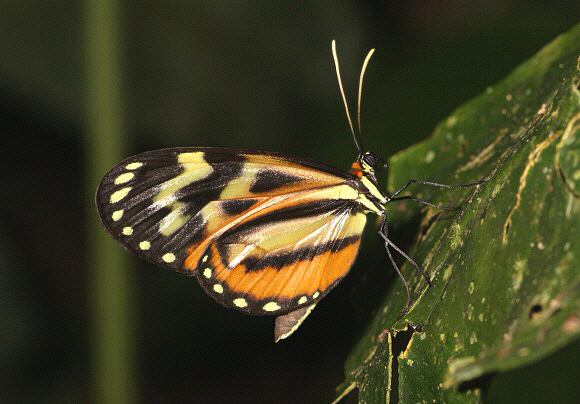
Introduction
The Ithomiini comprises of 376 known species, although it is likely that at least another 30 will be discovered in the near future. All are confined to the neotropical region. Ithomiines are unpalatable to birds, and are consequently mimicked in appearance by many other species.
These include other unpalatable species (Müllerian mimics), not only from the Ithomiini but also from several other butterfly families. There are also a large number of edible species (Batesian mimics) which have evolved similar patterns. Birds have the ability to memorise butterfly patterns and so learn to avoid eating noxious species, but are also fooled into ignoring similarly marked edible species.
Ithomiines are characterised by having small eyes, slender abdomens and long drooping antennae that lack distinct clubs. Males have a plume of long androconial scales or “hair pencils” on the costa of their hindwings. These are hidden from view when the butterflies are at rest, but are displayed when the wings are held open during courtship. Other Ithomiine characteristics include a very slow and deep wing beat, and a preference for inhabiting the darkest recesses of the forest understorey.
There are basically 2 types of Ithomiine. The first type are the black and orange-banded “tigers”, many of which are mimicked by other species due to their unpalatability to birds. The second type are the “glasswings”, recognised by their transparent or translucent wings, prominent veins, and orange wing margins. Many genera contain examples of both of these types, and in some cases an individual species may produce adults of both forms according to location.
Most novices find the Ithomiini very difficult to identify. Using only the patterns to identify species is very unreliable because there are so many similar species. Also many species produce a variety of different colour forms according to locality and season. The best approach therefore is to use the hindwing venation and other anatomical features to identify the genus, and to then look at the wing patterns to short-list the likely species.
There are 18 known species in the genus Hypothyris, of which 13 are found in Peru.
Hypothyris euclea is a common and widespread species found from Costa Rica to Bolivia. There are currently 21 described subspecies.
Hypothyris euclea peruviana was formerly known as hemilas, and has at various times been placed incorrectly in other genera, namely Ithomia and Ceratinia. It is restricted to Peru.
Habitats
This species occurs in rainforest and humid deciduous forest at altitudes between 200-1200m.
Lifecycle
The eggs are white. They are laid in batches of up to 80 beneath leaves of Solanum (Solanaceae) growing along forest edges. The caterpillars are gregarious. They feed diurnally on the leaf tissue, leaving the midrib and veins intact. When fully grown they are black with tiny white dots along the back. The underside of the abdomen and the anal segment are white, and the prolegs are pale green. The chrysalis is golden, smooth, and shaped like a raindrop.
Adult behaviour
Hypothyris euclea is usually seen singly. It flies in areas where dappled sunlight filters down from the canopy to the forest understorey. In overcast conditions it leaves the forest interior and can be seen feeding at Eupatorium flowers growing in forest glades and along riverbanks.
Males sequester pyrrolizidine alkaloids from Heliotropium, Tournefourtia, Myosotis (Boraginaceae), Eupatorium, Neomiranda and Senecio (Asteraceae). These chemicals confer toxic qualities to the butterflies which deter bird attacks. The chemicals are also used in the production of pheromones. Often the males of several Ithomiine species will gather together at communal leks, where they release these pheromones from hair-like androconial scales on the leading edge of their upperside hindwings. These attract more males, which in turn release further pheromones.
After a few days the lek may include 50 or more adults comprised of as many as dozen different species. Passing females are attracted to the leks by the complex fragrances. Their presence stimulates the males to open their wings and release further pheromones that entice them into copulation.
Females obtain sustenance from the nectar of Inga, Cephaelis, Psychotria etc, and also visit bird droppings.
